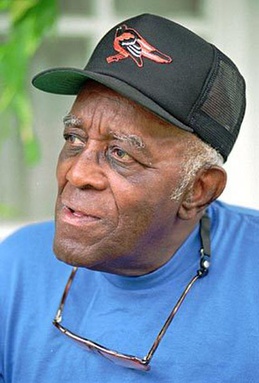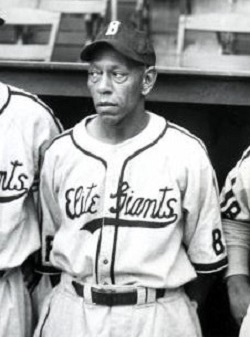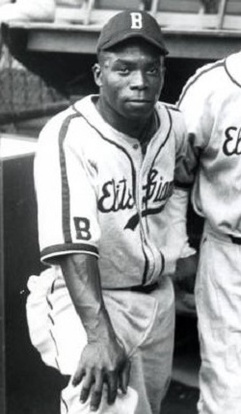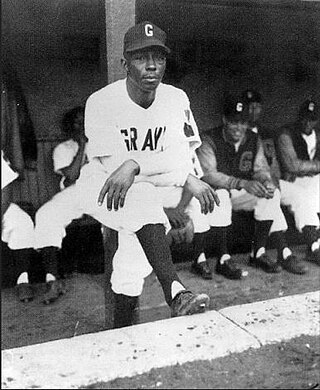
Leon Day was an American professional baseball pitcher who spent the majority of his career in the Negro leagues. Recognized as one of the most versatile athletes in the league during his prime, Day could play every position, with the exception of catcher, and often was the starting second baseman or center fielder when he was not on the mound. A right-handed pitcher with a trademark no wind-up delivery, Day excelled at striking batters out, especially with his high-speed fastball. At the same time, he was an above-average contact hitter, which, combined with his effectiveness as a baserunner and his tenacious fielding, helped cement Day as one of the most dynamic players of the era.
The Negro American League was one of the several Negro leagues created during the time organized American baseball was segregated. The league was established in 1937, and disbanded after its 1962 season.
The Mutual Association of Eastern Colored Clubs, more commonly known as the Eastern Colored League (ECL), was one of the several Negro leagues, which operated during the time organized baseball was segregated.
The first Negro National League (NNL) was one of the several Negro leagues that were established during the period in the United States when organized baseball was segregated. The league was formed in 1920 with former player Rube Foster as its president.
The Homestead Grays were a professional baseball team that played in the Negro leagues in the United States.

The Baltimore Elite Giants were a professional baseball team that played in the Negro leagues from 1920 to 1950. The team was established by Thomas T. Wilson, in Nashville, Tennessee as the semi-pro Nashville Standard Giants on March 26, 1920. The team was renamed the Elite Giants in 1921, and moved to Baltimore, Maryland in 1938, where the team remained for the duration of their existence. The team and its fans pronounced the word "Elite" as "ee-light".

The East–West All-Star Game was an annual all-star game for Negro league baseball players. The game was the brainchild of Gus Greenlee, owner of the Pittsburgh Crawfords. In 1933 he decided to emulate the Major League Baseball All-Star Game, using Negro league players. Newspaper balloting was set up to allow the fans to choose the starting lineups for that first game, a tradition that continued through the series' end in 1962. Unlike the white All-Star game which is played near the middle of the season, the Negro All-Star game was held toward the end of the season.

William Byrd was an American professional baseball player in the Negro leagues. Born in Canton, Georgia, he was a right-handed pitcher. He was named in eight All-Star games for six seasons. Byrd also saw action with the Criollos de Caguas and Cangrejeros de Santurce clubs of the Puerto Rico Winter League, where he was considered one of the best hurlers. He died at age 83 in Philadelphia, Pennsylvania.

Felton "Skipper" Snow was a Negro leagues professional baseball player who played for the Nashville Elite Giants that later became the Columbus Elite Giants, the Washington Elite Giants, and the Baltimore Elite Giants. Snow played on the West Squad in the East-West All-Star Games of 1935 and 1936. In 1940, he became a player-manager for the Baltimore Elite Giants.
The following are the baseball events of the year 1948 throughout the world.

James Raleigh "Biz" Mackey was an American catcher and manager in Negro league baseball. He played for the Indianapolis ABCs (1920–1922), New York Lincoln Giants (1920), Hilldale Daisies (1923–1931), Philadelphia Royal Giants (1925), Philadelphia Stars (1933–1935), Washington / Baltimore Elite Giants (1936–1939), and Newark Dodgers/Eagles.

Henry Allen Kimbro, nicknamed "Jimbo", was an American Negro league outfielder from the late 1930s through the early 1950s. He played for the Washington Elite Giants, Baltimore Elite Giants, and the New York Black Yankees and managed the Birmingham Black Barons from 1952-1953 before retiring from baseball.

Elander Victor Harris was an American professional baseball outfielder and manager in the Negro leagues. Listed at 5 ft 10 in (1.78 m), 168 lb., Harris batted left-handed and threw right-handed.
The following is a timeline of franchise evolution in Major League Baseball. The histories of franchises in the National Association of Base Ball Players (NABBP), National Association of Professional Base Ball Players (NA), Union Association (UA), and American Association (AA) before they joined the National League are also included. In 1900 the minor league Western League renamed itself the American League (AL). All of the 1899 Western League teams were a part of the transformation with the Saint Paul Apostles moving to Chicago and to play as the White Stockings. In 1901 the AL declared itself a Major League. For its inaugural major league season the AL dropped its teams in Indianapolis, Buffalo and Minneapolis and replaced them with franchises in Boston, Philadelphia, and Baltimore and the Kansas City Blues moved to Washington to play as the Senators.

Jerry Charles Benjamin was an American Negro league baseball center fielder who played from 1931 to 1948. He played for the Knoxville Giants, Memphis Red Sox, Indianapolis ABCs/Detroit Stars, Birmingham Black Barons, Homestead Grays, Newark Eagles, and New York Cubans. Benjamin was part of the famous Grays that won nine pennants in eleven years, for which Benjamin was part of eight Negro National League pennant teams along with two Negro World Series championships in four Series appearances. In those contests, he batted .220 with five total runs batted in (RBI) while stealing five bases in eighteen hits. A three-time East-West All-Star, he had a .372 batting average in 1943. He led the league in a variety of categories over his sixteen season career. He led the league in triples twice. In 1937, he led the league in walks (thirty), stolen bases (thirteen), games (52). He led the league in stolen bases (thirteen) in 1930. He led the league in at-bats four times. In center field, he led the league six times in games played, twice in putouts, three times in assists, and two times each in errors committed and double plays.
The 1948 Negro World Series was the championship tournament for the 1948 season of Negro league baseball. It was the seventh edition of the second incarnation of the Negro World Series and the eleventh overall played. It was a best-of-seven playoff played between the Homestead Grays of the Negro National League and the Birmingham Black Barons, champions of the Negro American League. The Homestead Grays played home games in both Washington, D.C., and Pittsburgh. It was the fifth appearance for the Grays in the Series, the most for any team; Birmingham made their third appearance in the Series, with each being against the Grays. The Grays won the series in five games. The Black Barons featured the 17-year-old Willie Mays in his first professional season.

John G. Washington was an American Negro league first baseman in the 1930s and 1940s.










